As some of the most attractive fish in the fishkeeping hobby, angelfish are certainly a sight to behold. The unique personalities of these fish shine through when they’re kept in community tanks. Choosing the right angelfish tankmates can make or break their experience in your home aquarium.
This article takes a look at some of our top picks for angelfish tankmates. While there isn’t one single fish that will work perfectly with every tank and angelfish, the list should give you a good idea of which species to consider. Without further ado, let’s dive right in!
Best Angelfish Tank mates
1. Corydoras Catfish

- Care Level: Easy
- Temperament: Peaceful and calm
- Size: 1-4 inches
- Diet: Omnivore
- Minimum tank size: 20 gallons
We’re kicking things off with one of our favorite bottom feeders for community aquariums – the cory catfish. These little guys make great tankmates for angelfish due to their peaceful nature and subdued appearance. The angelfish is unlikely to view the cory catfish as a potential threat, and the latter ensures that the tank stays clean from uneaten food and other detritus.
The cory’s ability to keep the tank clean is especially useful in angelfish tanks due to the species’ penchant for messy eating habits. Your cories will be more than happy to munch on food scraps that make their way to the bottom of the tank. In doing so, they also help keep water parameters in check. Less decaying food means less of an ammonia spike in the tank.
2. Dwarf Gourami

- Care Level: Intermediate
- Temperament: Peaceful, but may pick fights with other colorful fish
- Size: 3-4 inches
- Diet: Omnivorous
- Minimum tank size: 10 gallons
Lest you think there’s nothing more to the dwarf gourami apart from their stunning color, these fish are also remarkably peaceful and suitable tankmates for angelfish. Gouramis are a species of fish that may demonstrate aggressive behavior if provoked, but they make a good match for the angelfish for the most part. The dwarf gouramis will stand up for itself if it needs to, but will generally stay out of the way.
One thing to note is that dwarf gouramis require more specific water conditions to thrive. For one, they prefer slightly acidic water with a pH between 6.5 and 7.0. For another, they favor soft water with a general hardness of less than 100ppm. If you can ensure your tank environment meets these requirements, the dwarf gourami makes for an excellent angelfish companion.
3. Black Skirt Tetra

- Care Level: Easy
- Temperament: Peaceful and non-aggressive
- Size: 3 inches
- Diet: Omnivore
- Minimum tank size: 15 gallons
Looking for a peaceful community fish with a unique appearance? Enter the Black Skirt Tetra! These attractive fish have a flat, rounded body shape with a beautiful black, white, and silver coloration. They are peaceful by nature and do best when kept in groups of 6 or more. These are schooling fish that require the protection and community of their own kind in order to thrive.
One might expect black and silver fish to look a little muted. However, the scales on the Black Skirt Tetra catch and reflect light, creating a sparkle that is sure to add beauty to any home aquarium. Placed next to the angelfish, the black skirt tetra creates a nice contrast in size and color. To keep both your back skirt tetras and angels happy, make sure to add lots of natural plants in your tank!
4. Bleeding Heart Tetra

- Care Level: Easy
- Temperament: Social – Generally peaceful if kept in a school
- Size: 3-3.5 inches
- Diet: Omnivore
- Minimum tank size: 20 gallons for a school of four
This one’s yet another excellent community fish that will make great tankmates for angelfish. The bleeding heart tetra is aptly named after the bright red splotch that adorns the center of its body. Many enthusiasts swear that the splotch looks heart-shaped, though there’s a ton of variation in how pronounced this feature is. Either way, there’s no denying that these are gorgeous fish.
Like most tetras, the bleeding heart is social and needs to be kept in a school. They may morph into nippy fish if kept in small numbers, so at least 4 individuals are ideal for the aquarium. Because these fish max out at 3.5 inches in length, they’re capable of holding their own against angelfish. They’re also quick swimmers, so they’d have no trouble feeding along with medium-sized tankmates.
5. Boeseman’s Rainbow Fish
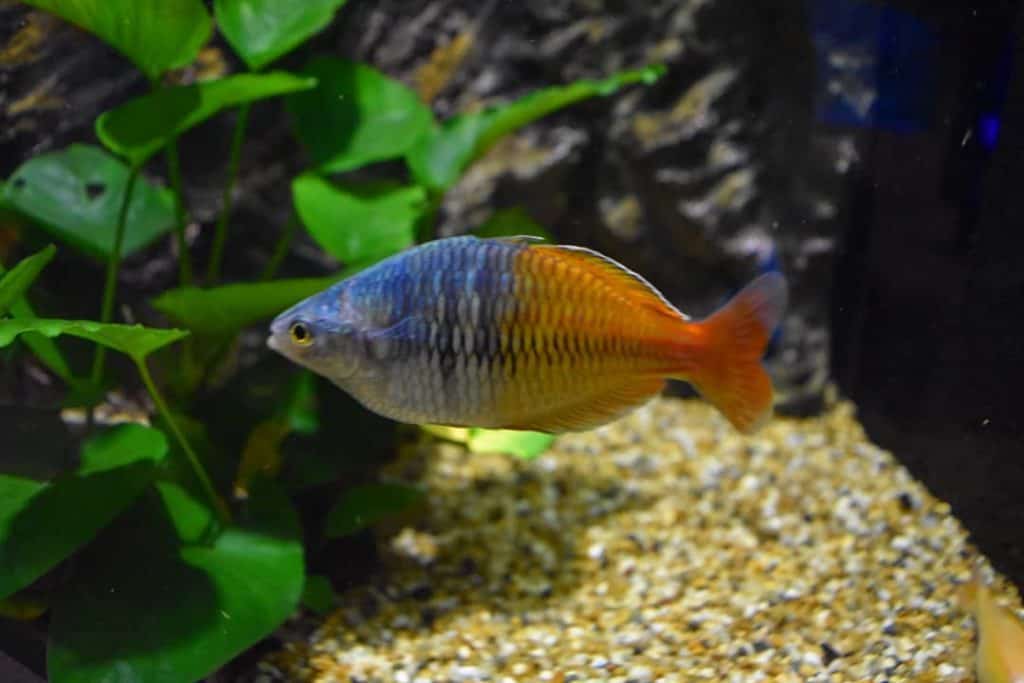
- Care Level: Easy
- Temperament: Peaceful
- Size: 3-4 inches
- Diet: Omnivore
- Minimum tank size: 40 Gallons
This one’s our favorite fish as far as angelfish tankmates are concerned! The Boeseman’s Rainbow Fish is an excellent angelfish match, especially when you take their size into account. Measuring approximately 4 inches in length, these fish are both large enough to avoid becoming prey, and small enough to remain agile. This is extremely handy come feeding time.
Many people also enjoy Boeseman’s Rainbow Fish because of its captivating colors. Its body is adorned with a yellowish-green hue, with several bright blue stripes running along its sides. Couple this with the fact that these are active fish, and you have yourself a real showstopper. Next to the angelfish, these fish will help to create a colorful and vibrant display in any aquarium.
6. Bolivian Ram

- Care Level: Easy
- Temperament: Peaceful
- Size: 3-4 inches
- Diet: Omnivore
- Minimum tank size: 30 gallons
Have you ever heard of the Bolivian Ram? With its yellowish, orange hue and black markings, this fish is a great addition to any angelfish tank. We especially love them for their peaceful nature. Bolivian Rams are both peaceful and placid, and tend not to bother their tankmates too much. This is beneficial, as angelfish of both genders don’t always respond well to more active tankmates.
As fellow omnivores, Bolivian Rams are also great tankmates when it comes to feeding time. Angelfish require a variety of foods, both frozen and live, and the Bolivian Ram will happily snap up foods just like they do. Both do equally well at snagging food for themselves, so there is no need to worry about one species outcompeting the other.
7. Common Plecostomus

- Care Level: Easy
- Temperament: Generally peaceful, though older plecos may be more prone to losing their patience
- Size: 15 inches
- Diet: Omnivore
- Minimum tank size: 75 gallons
It’s no secret that plecos are great for adult angels, as the latter can be quite the messy eater. Much like other bottom feeders, the common pleco will help keep the substrate clean of uneaten food and residue. They’re omnivorous species too, so you can expect to see them grazing around your tank day and night, taking a bite out of whatever is available.
Plecostomus are also incredibly easy to care for. This isn’t an invitation to slack on water quality or tank cleanliness, but you can rest easy knowing that with the proper conditions and diet, your pleco won’t have any issues.
8. Bristlenose Pleco
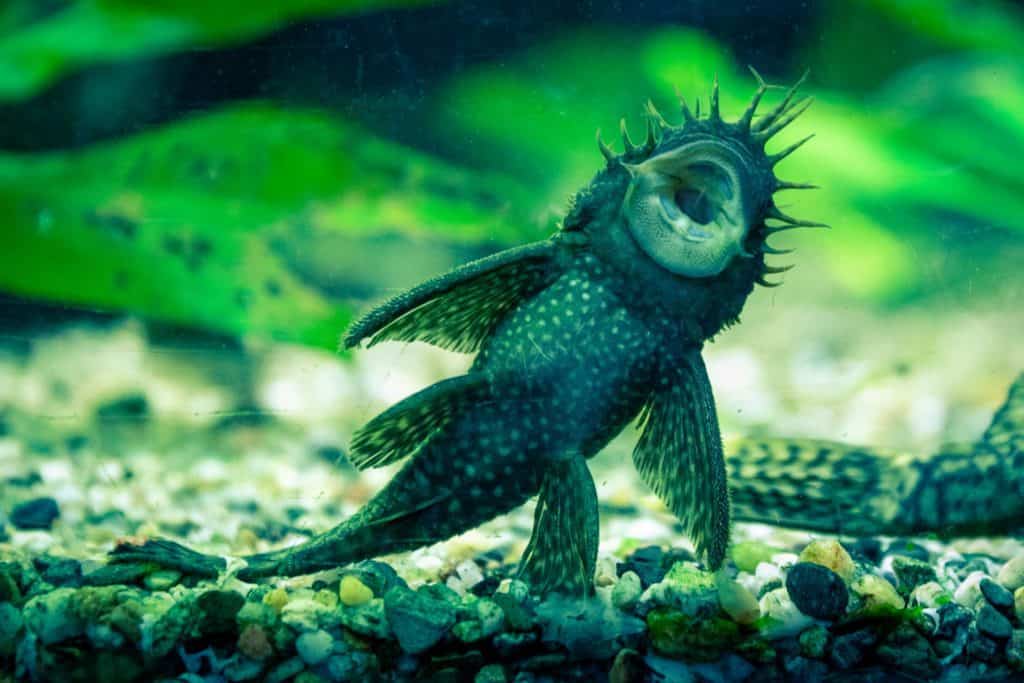
- Care Level: Easy
- Temperament: Very peaceful
- Size: 4-5 inches
- Diet: Herbivore
- Minimum tank size: 30 gallons
As a testament to their ubiquity, most people have spotted Bristlenose Plecos at their local pet stores – either being sold as a standalone species or placed within a community of other peaceful species. We love the speckled appearance of these suckerfish, and their value as algae-busters.
Bristlenose Plecos are not picky eaters, though it’s important to note that they are herbivores. They will pull their weight to keep your tanks algae-free, but most will also require herbivore pellets to thrive.
9. Cardinal Tetra
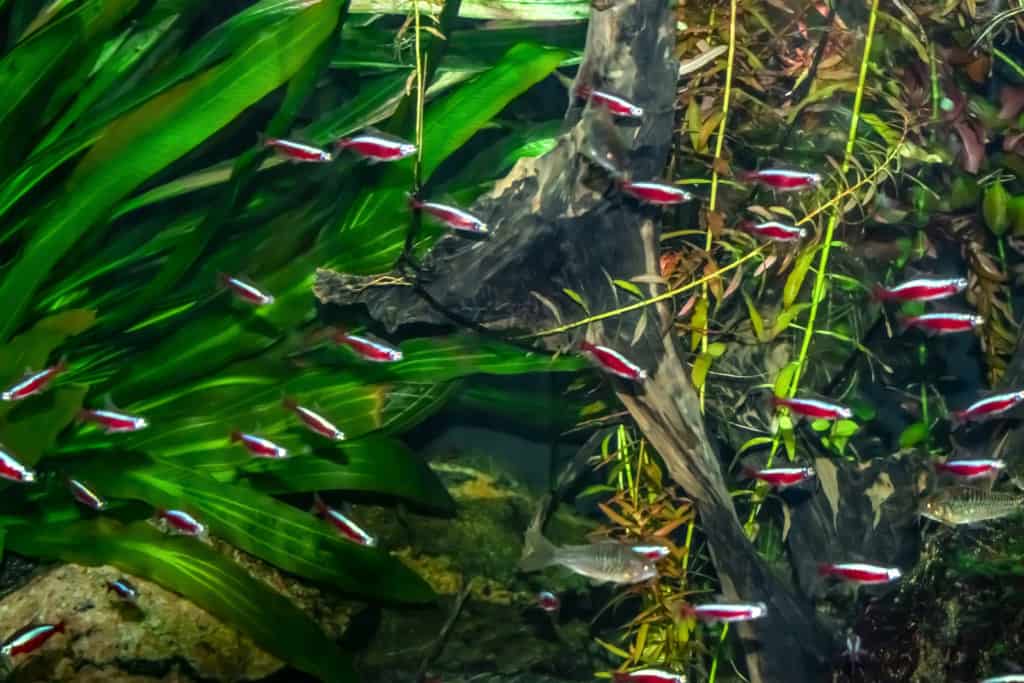
- Care Level: Intermediate
- Temperament: Peaceful and mild
- Size: 1.5 inches
- Diet: Carnivorous
- Minimum tank size: 20 gallons to accommodate a small school
You may mistake the cardinal tetra for the famous neon tetras at first glance, but there are actually slight differences between the two. For one, cardinal tetras are much smaller in size, ranging from about 1.5 to 2 inches, compared to neon tetras which grow larger, about 2-3 inches.
Despite their differences, both are hardy fish that make great additions to an angelfish tank. The cardinal tetra’s small size allows it to dart around without causing trouble for the angelfish, but its vibrant colors still provide a display of life and energy for the tank.
10. Discus Fish

- Care Level: Hard
- Temperament: Peaceful and shy
- Size: 6-10 inches
- Diet: Carnivorous
- Minimum tank size: 55 Gallons
As one would expect, the discus has a body shape that closely resembles a disc. But that’s not all these fish are known for. Their social nature and bright colors make them excellent choices for most aquariums. Next to the angelfish, the discus looks right at home.
In terms of personality, the discus fish is a great tank companion for angelfish— they tend to get along well and won’t constantly fight over territory. Both species of fish will leave the other alone, which is especially beneficial in a community tank.
11. Electric Blue Ram
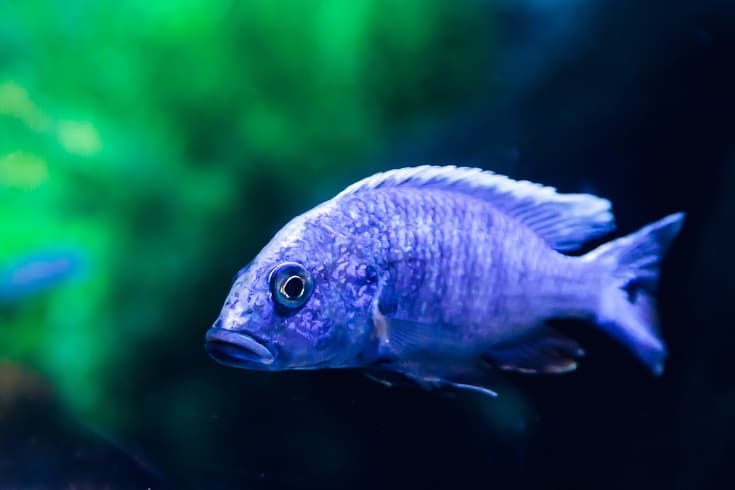
- Care Level: Moderate
- Temperament: Peaceful, but may demonstrate aggressive behavior during breeding
- Size: 1.4 – 1.6 inches
- Diet: Omnivore
- Minimum tank size: 20 gallons
Angelfish tank owners each have their own opinion when it comes to adding other tank mates. But, most agree that the electric blue ram makes excellent tank mates for the angelfish.
These fish are prized and adored for their distinctive blue hue, but they also have a social personality to boot. Just note that electric blue rams can get a little feisty during mating, so be sure to allocate a little more tank space to keep the aggression at bay.
12. Guppy

- Care Level: Easy
- Temperament: Peaceful, can be shy if not kept in schools
- Size: 2-3 inches
- Diet: Omnivore
- Minimum tank size: 10 gallons for a small school
Given the wide range of fish species available in the hobby, it may be surprising to see guppies included on this list. But these peaceful schooling fish are a popular choice for a good reason! As lively fish that thrive in a wide range of water conditions, guppies have both the resilience and the personality for angelfish tanks.
Guppies also enjoy the same diet as angelfish, which means feeding ought to be a breeze. Simply sprinkle fish food into the water column a couple of times per day, and both your angelfish and guppies will be able to feed until their bellies are full.
13. Hatchetfish
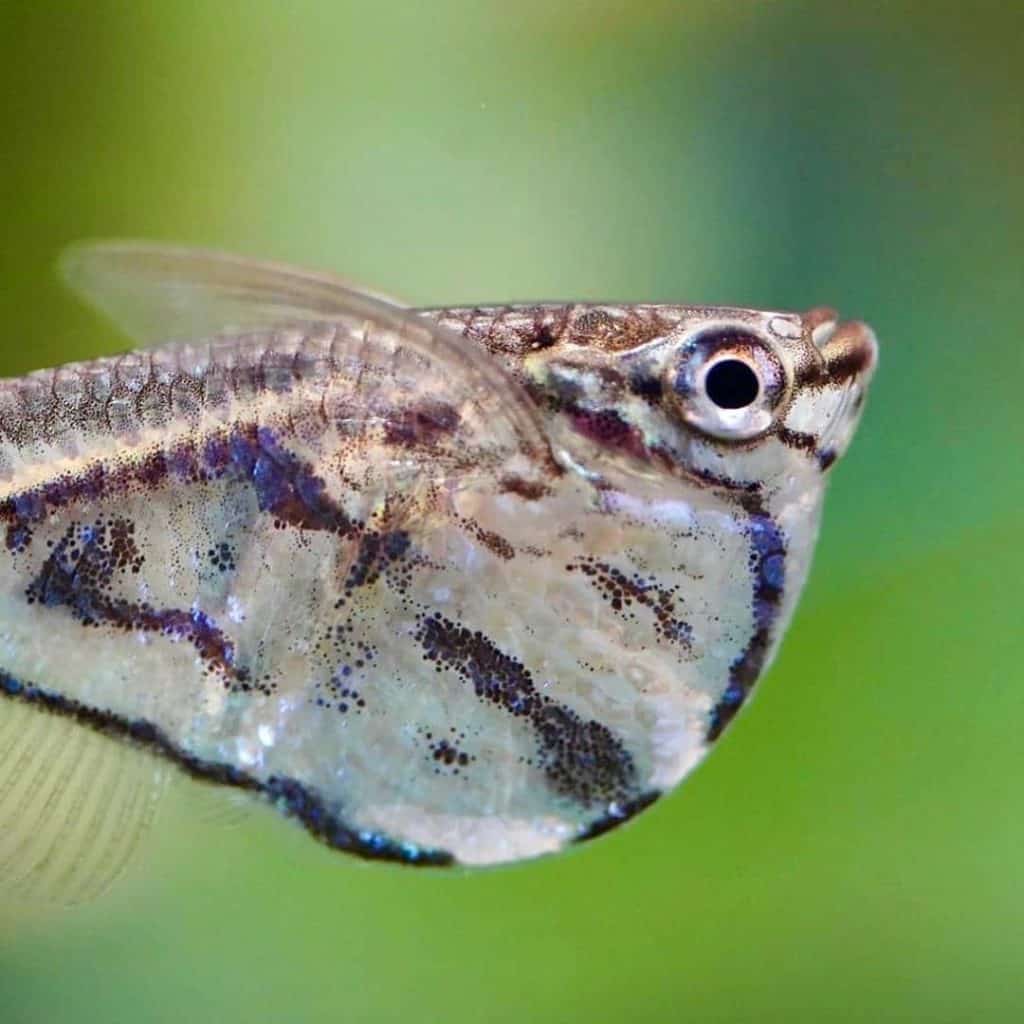
- Care Level: Intermediate
- Temperament: Peaceful – may even be too nervous
- Size: 2.5 inches
- Diet: Carnivore
- Minimum tank size: 20 gallons
We are big believers in stocking peaceful fish species in angelfish tanks—especially when that peaceful species brings a unique look and behavior with it. Hatchetfish do just that! These highly specialized fish earn their name from their famously asymmetrical body shape.
However, these fish max out at 2.5 inches, so please opt for adult fish that have absolutely no chance of falling prey to your angel.
14. Keyhole Cichlids
- Care Level: Easy
- Temperament: Peaceful
- Size: 4-5 inches
- Diet: Omnivore
- Minimum tank size: 20 gallons
What’s in a name? Keyhole cichlids are aptly named because these fish boast a distinct black spot at the base of their dorsal fin that looks like—you guessed it—a keyhole! Their hardy temperament and relaxed nature make keyhole cichlids great tankmates for angelfish. Just be sure to do your research and meet their specific water requirements.
15. Kribensis Cichlids

- Care Level: Easy
- Temperament: Peaceful and friendly
- Size: 3-4 inches
- Diet: Omnivore
- Minimum tank size: 10 gallons
Hailing from Nigeria and Cameroon, Kribensis cichlids are popular fish that stay relatively small and look absolutely stunning. Up to three inches in length, they feature a layer of yellowish scales over their body that provides tons of personality when swimming around the tank.
Like most members of the cichlid family, these fish prefer water pH levels on the slightly acidic side (6.0-7.5). Angelfish enjoy the same water conditions, so both species should be able to live harmoniously in the same tank. They’re both members of the cichlid family after all!
16. Kuhli Loach
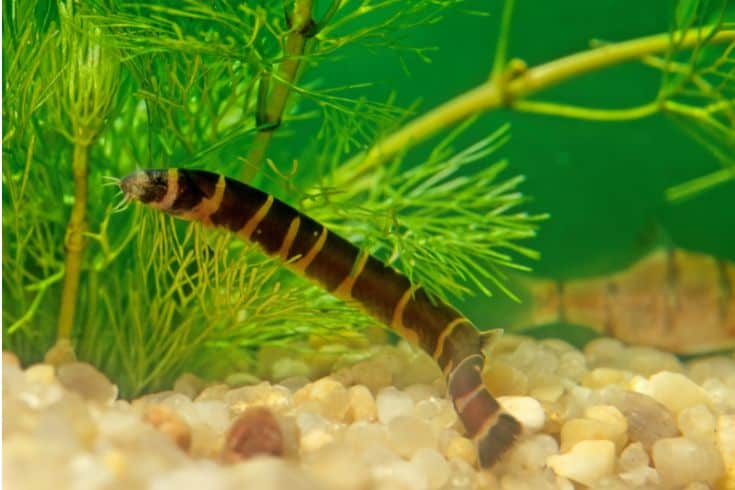
- Care Level: Intermediate
- Temperament: Peaceful
- Size: 3-6 inches
- Diet: Omnivorous
- Minimum tank size: 20 Gallons
We don’t know how and why, but Kuhli Loaches and angelfish seem like a match made in heaven! The former is a peaceful species known for its shy demeanor, while the latter is a livelier and bolder species. Together, they can provide hobbyists with a blend of personalities that’s hard to beat!
Because Kuhli loaches can grow rather large, we recommend a 30-gallon tank as the minimum. 20 gallons is fine if you’re only housing Kuhli loaches, but since we’re including an angelfish, we suggest upgrading to something larger. Not only will your fish appreciate the extra space, but you’ll also enjoy a more active and colorful aquarium.
17. Lemon Tetra

- Care Level: Easy
- Temperament: Easy-going
- Size: 2 inches
- Diet: Omnivore
- Minimum tank size: 20 gallons
What’s bright yellow, has red eyes, and is perfectly happy when placed in a tank with angelfish? That’s right – lemon tetras! Many people opt to keep tetras with angelfish, but we think the lemon tetra makes one of the best visual matches. The bright yellow hue of the tetras serves as a fantastic contrast to their tankmates.
Lemon tetras are also shy fish that will contribute towards a peaceful tank. They’re more than happy to let the angelfish have the spotlight, but they will also make sure they have enough to eat! Truly, lemon tetras make an ideal choice for angelfish tanks.
18. Mollies

- Care Level: Easy
- Temperament: Peaceful and friendly
- Size: 3.5 to 6 inches
- Diet: Omnivorous
- Minimum tank size: 20 Gallons
As social fish that come in a wide variety of colors, mollies are also great tank mates for angelfish. Just note that mollies prefer brackish water, so you’ll want to make some adjustments to your tank. Once you’ve done that, you should have a group of happy fish on your hands!
In terms of diet, most mollies will be happy with the same type of food that you’re giving to your angelfish. Just make sure your angelfish aren’t monopolizing the food, and you should be good to go.
19. Neon Tetra

- Care Level: Easy
- Temperament: Peaceful and friendly
- Size: 2 inches
- Diet: Omnivorous
- Minimum tank size: 10 gallons for a small school
If there’s any one species of tetras that can act as the spokesperson for all tetras, then it’s got to be the neon. These beautiful fish have captivating iridescent blue and green stripes that any aquarium owner will find hard to resist.
To add to its list of charms, the neon is a hardy tetra that is perfectly suited for community aquariums. Its peaceful disposition means it won’t compete with your angelfish, while its small size ensures that it can find nooks and crannies to hide when needing a break.
20. Otocinclus Catfish

- Care Level: Easy
- Temperament: Peaceful and calm
- Size: 2 inches
- Diet: Herbivorous
- Minimum tank size: 10 gallons
The otocinclus catfish is sometimes known as dwarf suckers, and it makes sense. These pint-sized bottom feeders look like miniature catfish, with a wide sucker mouth they use to pick up algae and other leftover food.
Because these fish are herbivorous, you’ll need to supplement their natural diet with algae wafers or spirulina tablets. The fact that they have slightly different dietary needs compared to the angelfish can be a positive, as it minimizes the odds of competitive behavior. Most reputable angelfish breeders will attest to the fact that these fish have an aggressive streak!
21. Platies
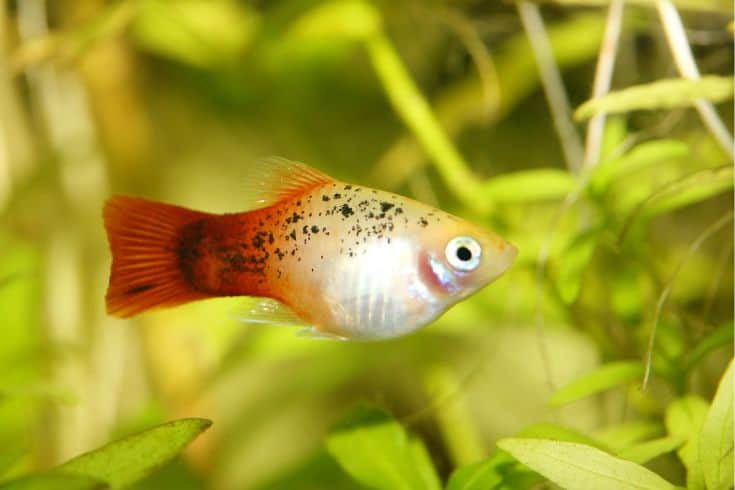
- Care Level: Easy
- Temperament: Peaceful and social
- Size: 3 inches
- Diet: Omnivore
- Minimum tank size: 20 gallons for a small school
Much like mollies and guppies, platies are yet another colorful livebearer that will add life to any tank. These fish, though peaceful, need a school of three to five individuals for safety and comfort.
In terms of diet, these fish are far from being the fussiest kids on the block. They are omnivores that will happily indulge in the same foods your angelfish will.
22. Praecox Rainbow Fish

- Care Level: Easy
- Temperament: Peaceful, but may eat smaller shrimp and fry
- Size: 3 inches
- Diet: Omnivore
- Minimum tank size: 20 gallons
Looking for another colorful tankmate for your angelfish? The Praecox Rainbow Fish could be a great option. These rainbow fish grow up to three inches in size, and their coloration closely resembles that of neon tetras. Think of these fish as being like a larger, more rounded version of the latter!
23. Blue Ram Cichlids

- Care Level: Intermediate
- Temperament: Peaceful, but may get territorial in a small tank
- Size: 4 inches
- Diet: Omnivore (But mostly meat)
- Minimum tank size: 30 gallons for a proper community tank
Judging by the name of these fish, you’d expect blue ram cichlids to be some of the most aggressive fish out there. Thankfully, this is far from the truth. These guys will make awesome companions for your angelfish!
24. Rummy Nose Tetras

- Care Level: Easy
- Temperament: Peaceful and a little shy
- Size: 1.5 inches
- Diet: Omnivore
- Minimum tank size: 20 gallons
Rudolph isn’t the only one with a bright red nose. Rummy nose tetras have the same unique coloring too! These guys get along perfectly with angelfish, and will look amazing to boot.
25. Rubbernose Pleco

- Care Level: Easy
- Temperament: Peaceful, though slightly reclusive
- Size: 7 inches
- Diet: Herbivores
- Minimum tank size: 30 gallons
Okay, we promise – this is the only large fish we’ll suggest. Rubbernose Plecos grow up to 7 inches in size, and have muted colors. These fish will keep to themselves, working diligently to clean up after your angelfish.
26. Silver Dollar
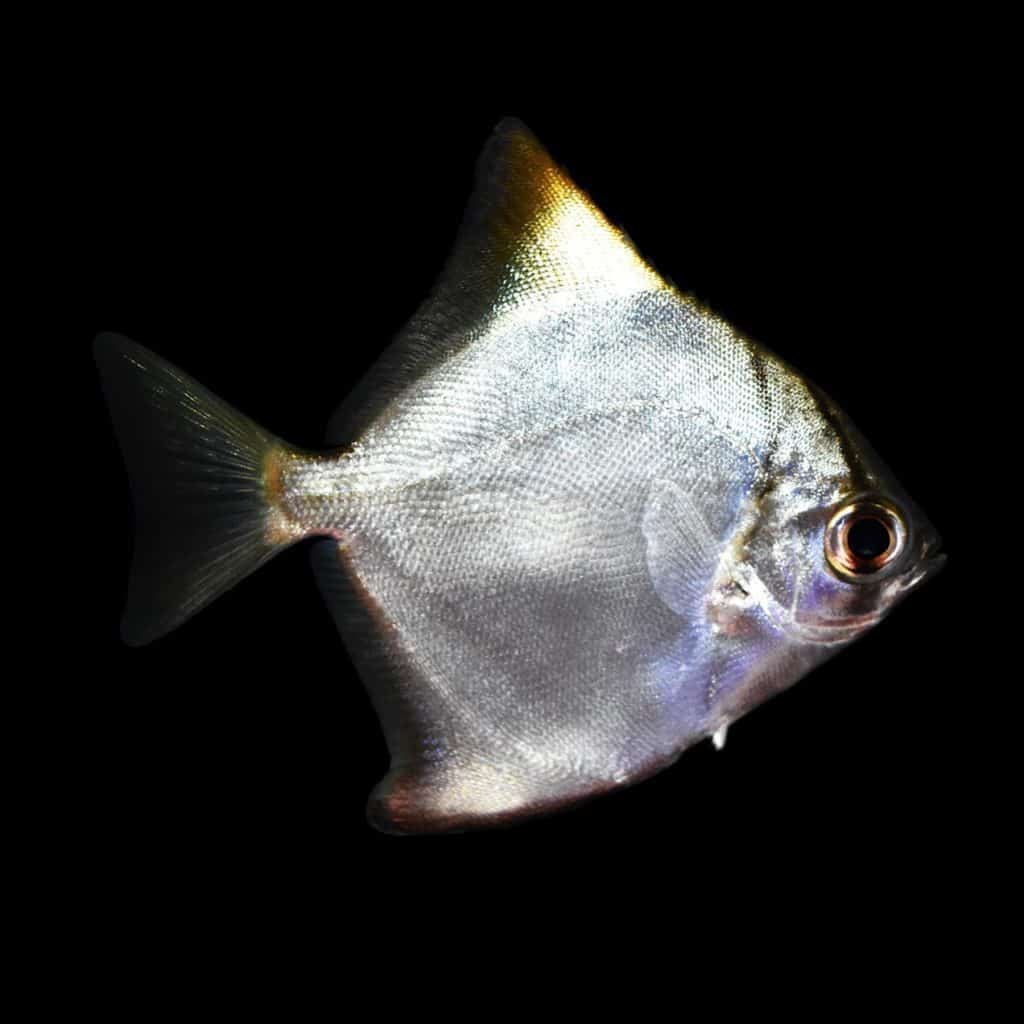
- Care Level: Easy
- Temperament: Peaceful, can be skittish if not kept in schools
- Size: 6 inches
- Diet: Omnivores (But prefers plant-based foods)
- Minimum tank size: 100 gallons
You read that right. Yes, silver dollars need at least 100 gallons of water, despite being relatively tiny in size. They are highly active and need large swimming spaces, so please make sure you have an adequate tank size before buying one.
If you’re able to provide your silver dollar with the right environment, these fish will make fantastic friends for your angelfish. Trust us!
27. Synodontis Catfish

- Care Level: Easy
- Temperament: Gentle and friendly
- Size: 4 inches
- Diet: Omnivore
- Minimum tank size: 20 gallons
What makes this friendly fish a great companion for your angelfish? Well, for one, the synodontis catfish is gentle and friendly. Your angelfish will appreciate its presence. Another plus is they’ll clean up any uneaten food. Keeping your tank’s water parameters in check has never been easier!
28. German Blue Ram

- Care Level: Intermediate
- Temperament: Peaceful, but needs sufficient space
- Size: 2.5 inches
- Diet: Omnivore
- Minimum tank size: 30 gallons for a proper community tank
German blue rams belong to the cichlid family, just like angelfish. They’ll make great additions to your angelfish tank, but just make sure to give them sufficient space!
29. Three-Spot Gourami

- Care Level: Easy
- Temperament: Generally peaceful, but males can be territorial around each other
- Size: 5 inches
- Diet: Omnivore
- Minimum tank size: 30 gallons for a small school
This fish gets its name from the two spots located on the side of its body. Where’s the third spot? It’s the eye! Quirky as their appearance may be, these fish are extremely easy to care for, making them great angelfish buddies.
30. Zebra Loaches
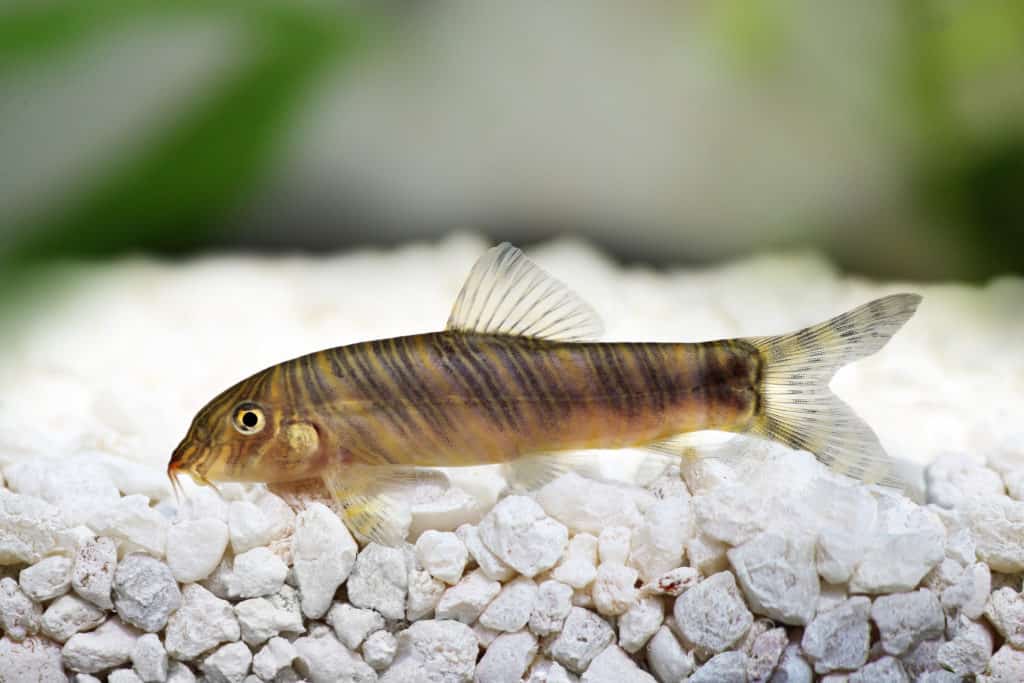
- Care Level: Intermediate
- Temperament: Peaceful
- Size: 3.5 inches
- Diet: Omnivore
- Minimum tank size: 30 gallon
These fish are brown and black, so while they may not resemble zebras in the truest sense, they’re still pretty great angelfish tankmates!
31. Swordtails
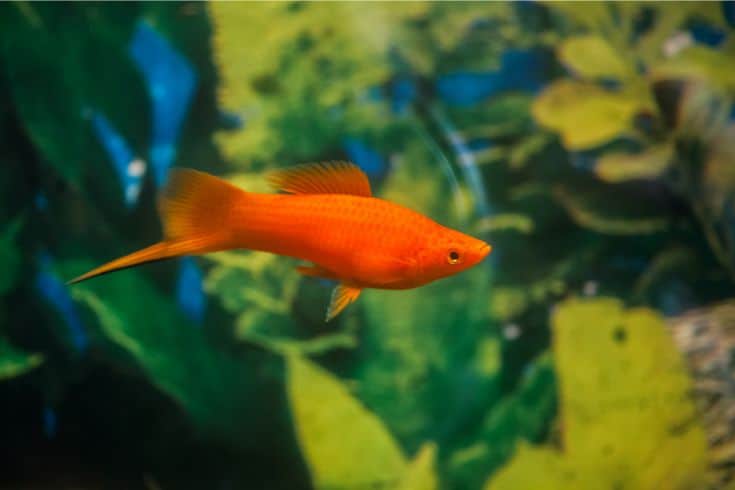
- Care Level: Easy
- Temperament: Peaceful
- Size: 5.5 inches
- Diet: Omnivore
- Minimum tank size: 15 gallons
We might have saved the best for last. Swordtails are distinctive in both shape and color, much like angelfish! Put them next to each other, and you’ll have yourself a stunning display.
Final Thoughts
Whew! That was a long list! But we hope it speaks to the versatility of angelfish as a species. These fish can get along with most other fish, as long as they’re peaceful and able to stand up for themselves. You want everyone to feel at ease in their new home.
Thanks for reading, and happy fishkeeping!
